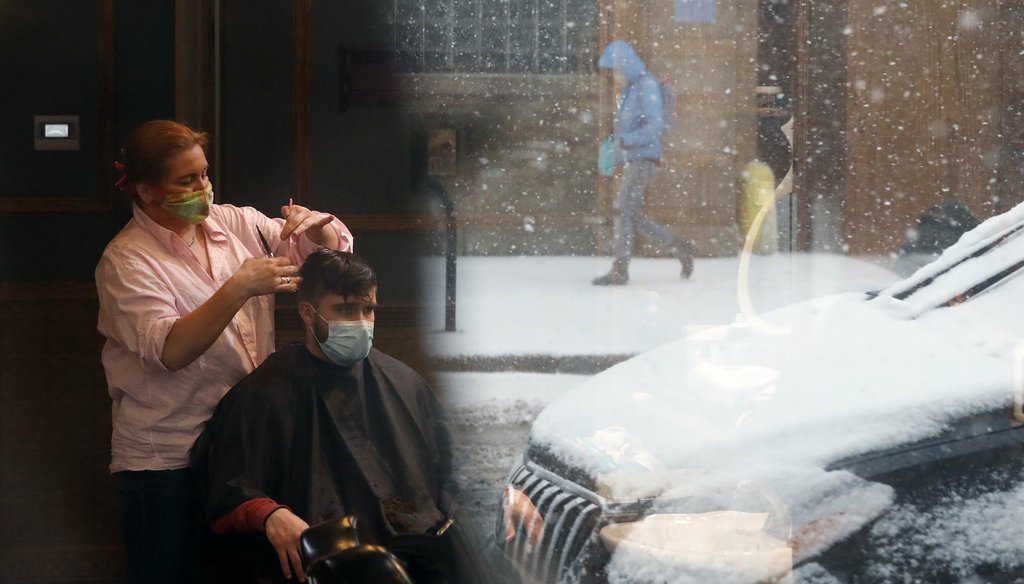Get PolitiFact in your inbox.

Gina Loukas, left gives a haircut to Ryan as a lone pedestrian is reflected in the barbershop window Monday, March 15, 2021, as fresh snow falls in Chicago. (AP Images)
A year into the pandemic, masks have become part of daily life. Want to use a face covering to broadcast your patriotism? Online stores sell masks with U.S. flags. Wondering how to pair your mask with your outfit? Magazines show how celebrities do just that at the big awards shows. ("These stars made a statement that was all about style and safety.")
With vaccination rates climbing, it seems like we’re drawing nearer to the light at the end of the long pandemic tunnel. But it’s unlikely that widespread mask-wearing will go away any time soon. It’s still unknown whether vaccinated people can spread the virus to others, so public health experts stress that everybody, including those who have been inoculated, should continue to wear masks in community spaces.
Still, not everyone is sold on masks, and some states are rolling back mask mandates. We’ve been reviewing mask science since the start of the pandemic, and we’re persuaded that mask wearing is a good idea. But if you’re not, we wanted to address your questions head on.
Here’s the latest research on the efficacy of masks and answers to questions, from readers and our own team, on what we know and what we don’t about mask wearing.
Masks are most effective as "source control," which means preventing infected people from spreading the virus to other people.
Respiratory droplets with the virus are expelled into the air when infected people cough, talk, sneeze, or breathe. These droplets quickly evaporate and shrink to become tiny airborne particles.
But if an infected person is wearing a mask, it will catch and contain the larger droplets in the humid space between the person’s mouth and the mask. In this environment, droplets take nearly a hundred times as long to transform into airborne particles. So masks reduce the spread of infectious particles
This makes a meaningful difference when everyone is wearing masks. If you’re the only one wearing a mask in a public location, it won’t necessarily protect you from being infected. But if everybody is wearing a mask, your odds of infection will go down by quite a bit.
Yes, it’s true that face masks do not block some very fine particles in the air that may be transmitted by coughs or sneezes. That means if coronavirus particles are in the air, the masks aren’t a reliable way of preventing someone who’s wearing one from contracting the virus and getting COVID-19 (although there is some evidence that they are better than nothing).
"Unless one wears a properly fitted respirator mask for all interactions outside of the household, masks cannot, by themselves, completely interrupt transmission," said Babak Javid, a professor of medicine at the University of California, San Francisco. "Nonetheless, from what we know about the biology of the disease, and the biophysics of droplet and aerosol production, there is a strong rationale for why masks can have some effect in both protecting the wearer and as source control."
Public health experts have based their guidance on a variety of scientific studies: systematic reviews, ecological studies and laboratory studies.
Systematic reviews are papers that pool existing research and try to answer a narrowly defined question using a larger data set than any of the studies had individually. According to scientific hierarchies of evidence, systematic reviews are generally thought to produce the most reliable evidence, and multiple reviews have indicated that masks stop the spread of COVID-19 and other respiratory diseases.
There have also been a wealth of ecological studies on masks and COVID-19. These studies analyze the effect that specific localized public health measures have on coronavirus case rates after they’re implemented. These papers have consistently found that mask mandates cause sharp declines in coronavirus case rates.
Finally, scientists have studied the spread of coronavirus particles in laboratory settings and found that masks are effective at stopping them from dispersing into the air, suggesting that they also function that way in real world settings.
A randomized controlled trial is a scientific study that randomly sorts participants into an experimental group and a control group to study the effect of a particular variable on the outcome. They’re considered the gold standard of scientific study.
But when it comes to COVID-19, there are important ethical considerations that bar scientists from running these types of studies right now. To conduct a randomized controlled trial on the efficacy of masks, researchers would have to randomly assign some members of a community not to wear a face mask for a long period of time to see whether they got sick at higher rates than a control group.
Practically there is no way that scientists could run a study like this during a global pandemic without endangering trial participants and other people they encountered out in the world.
"Randomized controlled trials are pretty much the gold standard, but they’re not always ethical," said Mary Kathryn Grabowski, an assistant professor in epidemiology at Johns Hopkins University. "We can’t just send people out without masks in the middle of a pandemic in the same way we can’t randomize people to not use a parachute when they jump out of a plane."
Tight-fitting N95 masks (also known as respirators) are more effective than surgical masks, and surgical masks are generally more effective than homemade masks. However, due to a persistent supply shortage in N95s, the Food and Drug Administration still recommends that members of the general public forego them. Instead, they should be reserved for medical workers and other first responders.
The most effective homemade masks are made of thick cloth and make a tight seal around the wearer’s face. So at best, using thick or layered fabric to make a homemade mask could be as effective as using some surgical masks. At worst, it prevents at least some of your respiratory droplets from spreading to others while in public.
"Given the current crisis, and lacking an alternative, many layers of densely woven fabric would be the most effective, because it allows for lots of voids in the layers where particles can be trapped," Richard Peltier, an assistant professor of environmental health sciences at the University of Massachusetts-Amherst, previously told PolitiFact. "The mask needs to seal as tightly as possible to the face to avoid leaks, though this may not be possible with different designs, fabrics, or face shapes. Thin or porous fabrics are the least likely to be effective."
A study published in October 2010 tested how cloth masks and common fabrics fared when sprayed with aerosols at different speeds. All of the materials performed worse than N95 respirators. But some, such as cotton towels and scarves, were in the range of some surgical masks. The authors cautioned that fabric materials "show only marginal filtration performance against virus-size particles when sealed around the edges."
Under ideal circumstances, no face masks are intended to be worn for more than one encounter. That guidance also extends to homemade masks.
"At the end of the day, these cloth masks should be treated as contaminated materials that you bring in to your home — they need to be laundered in hot soapy water, and you’d need to consider sanitizing in bleach or hydrogen peroxide regularly," Peltier said.
There were a lot of unknowns about the coronavirus during the first stages of the pandemic. In some ways public health experts were calling shots in the dark. Many were unsure whether the virus spread through surfaces or through the air, whether asymptomatic people could transmit the virus, and whether mask-wearing was as effective in community settings as it appeared to be in health care settings, where many previous scientific studies had been conducted.
Early on in the pandemic, public health officials and organizations consistently advised against people wearing face masks unless they had COVID-19, saying that masks had little value in preventing the general public from contracting the disease. However, many of these experts also noted that masks should be reserved for health care workers, who were running low on critical medical supplies. This guidance struck many people as contradictory: How could it be true that masks offer health care workers protection but not ordinary people?
On April 3, 2020, the Centers for Disease Control and Prevention appeared to reverse course, recommending that people cover their faces while out in public. This flip-flop sowed further confusion, with some social media users spreading outdated guidance months after the advice had changed.
The reason for this was that scientific studies cleared up some of the unknowns about mask wearing as the pandemic progressed. Aerosol studies of the virus appeared to show that it was airborne, studies found that asymptomatic people could still spread the virus to others and large-scale ecological studies seemed to show that mask mandates effectively decreased case rates.
When public health officials know more they offer better advice. In the case of masks, they made a new call as new research showed that their old guidance was outdated.
Our Sources
CDC, Interim Public Health Recommendations for Fully Vaccinated People, Mar. 8, 2021
FDA, N95 Respirators, Surgical Masks, and Face Masks
PolitiFact, Face masks, including homemade ones, are effective COVID-19 protection, experts say, May 18, 2020
PolitiFact, Why randomized controlled trials on mask wearing and the coronavirus are scant, Mar. 12, 2021
PolitiFact, Are homemade face masks effective against COVID-19? Apr. 1, 2020
Emerging Infectious Diseases, Face Mask use and control of respiratory virus transmission in households, Feb. 2009
PNAS, An evidence review of face masks against COVID-19, Jan. 26, 2021
PNAS, Identifying airborne transmission as the dominant route for the spread of COVID-19, Jun. 11, 2020
International Journal of Nursing Studies, A rapid systematic review of the efficacy of face masks and respirators against coronaviruses and other respiratory transmissible viruses for the community, healthcare workers and sick patients, Aug. 2020
Institute for Work and Health, Experimental vs. observational studies, Feb. 2016
Wiley Online Library, The use of masks and respirators to prevent transmission of influenza: a systematic review of the scientific evidence, Dec. 21, 2011
Emerging Infectious Diseases, Face Mask use and control of respiratory virus transmission in households, Feb. 2009
The Lancet, Physical distancing, face masks, and eye protection to prevent person-to-person transmission of SARS-CoV-2 and COVID-19: a systematic review and meta-analysis, Jun. 27, 2020
Annals of Internal Medicine, Effectiveness of Adding a Mask Recommendation to Other Public Health Measures to Prevent SARS-CoV-2 Infection in Danish Mask Wearers, Nov. 18, 2020
Factcheck.org, Danish study doesn’t prove masks don’t work against the coronavirus, Nov. 25, 2020
PolitiFact, In Context: As Trump criticizes, a look back at Fauci’s early coronavirus statements, Jul. 14, 2020
PolitiFact, No, a Danish study didn’t prove wearing masks is ineffective, Dec. 7, 2020
Science of the Total Environment, Understanding transmission and intervention for the COVID-19 pandemic in the United States, 2020
Centers for Disease Control and Prevention, Trends in County-Level COVID-19 Incidence in Counties With and Without a Mask Mandate — Kansas, June 1–August 23, 2020, Nov. 27, 2020
The New England Journal of Medicine, Visualizing speech-generated oral fluid droplets with laser light scattering, May 21, 2020
Nature Medicine, Respiratory virus shedding in exhaled breath and efficacy of face masks, Apr. 3, 2020
Cochrane Database of Systemic Reviews, Physical interventions to interrupt or reduce the spread of respiratory viruses, Jul. 6, 2011
The Atlantic, Everyone thinks they’re right about masks, Apr. 1, 2020
























